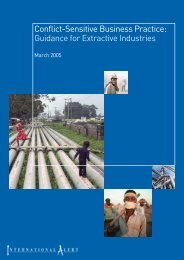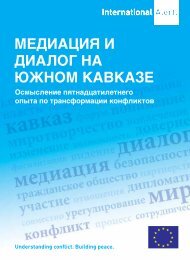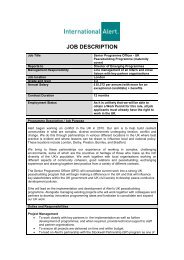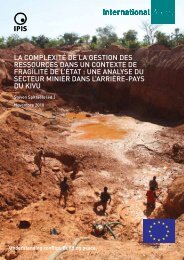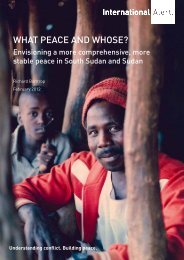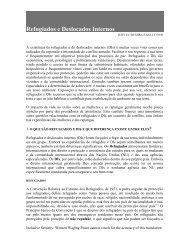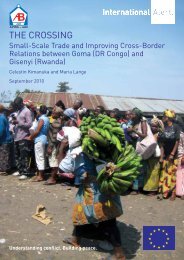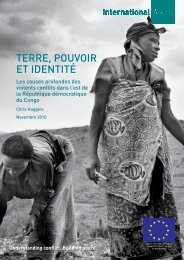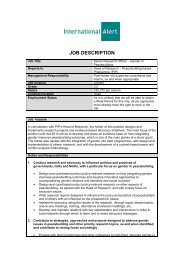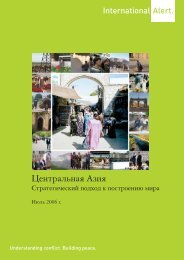Full report - International Alert
Full report - International Alert
Full report - International Alert
- No tags were found...
You also want an ePaper? Increase the reach of your titles
YUMPU automatically turns print PDFs into web optimized ePapers that Google loves.
15 • Women’s Bodies as a Battleground: Sexual Violence Against Women and Girls During the War in the Democratic Republic of Congoall cases of rape they come across. At each data-collection site, staff of local NGOs are asked toaccompany the women to the place where the interviews or focus group meeting will take place.1.4.2.2 The military and Maï Maï rebelsThe sample also included Maï Maï rebels and soldiers. A total of 50 soldiers and two Maï Maï rebels tookpart in the survey.1.5 Data-collection techniquesThe two main techniques used to collect data were semi-structured individual interviews, using an outlinequestionnaire (see Appendix 1), and focus groups. The original version of the questionnaire was drawnup in French and translated into Kiswahili and Mashi. 8 Two experts in these languages checked theaccuracy and faithfulness of the translation. The examination of 3,000 files held in the archives of variouslocal organisations helped with the analysis and validation of the information gathered directly from thevictims themselves.The victims were also interviewed through 23 focus groups, each made up of 12 participants. Theadvantage of the focus group method is that it allows the views and opinions of members of the group tobe gathered quickly. On the other hand, it has the disadvantage that shy people do not feel sufficiently attheir ease to express themselves and give their opinion in a group situation. Most of the discussions thattook place within focus groups started off in a rather timid manner. However, as the debate continued,the participants began to relax and to express their viewpoint in an open and honest way.1.6 Ethical considerationsThe aims and significance of the study were explained to the participants before the interviews and focusgroups took place. Given that the very fact of revealing the abuse they had endured could put the life ofvictims in danger, and because of the volatile situation in South Kivu, the possibility of bias in the study’sfindings was obviously increased. The principle of voluntary participation was therefore applied, and itwas made clear at the start of each interview that anonymity and confidentiality were guaranteed. Theinformants were also told that a tape recorder would be used, so that their replies could be accuratelyrecorded and then written down. The tapes were erased after the data had been analysed.1.7 System for analysing the dataReplies were grouped into general themes and then the various categories identified. In the case of dataobtained from focus groups, synthesis analysis was used for each group, followed by comparative analysisof the groups, in order to draw up general categories. The categories drawn from the individual interviewsand focus groups were merged. A qualititative analysis of the data was then carried out.The demographic data obtained from the interviews were recorded in Excel and a statistical analysiscarried out with STATISTICA 5.2. Descriptive statistics were used for this purpose. The location of thesites and their description on paper were carried out using the Arcview programme. Information drawnfrom various documents belonging to victim-support organisations and centres was also statisticallyanalysed. The description of the location and characteristics of the selected sites was made usingHealthmap on WHO.30.8.Local languages.





